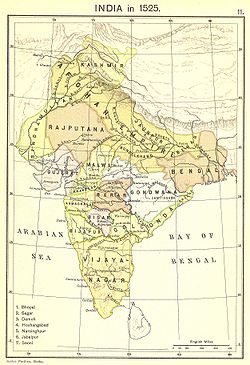This article has multiple issues. Please help improve it or discuss these issues on the talk page. (Learn how and when to remove these messages)
|
Gondwana | |
|---|---|
 Gondwana kingdom 1525, as depicted in central India, on a map drawn in 1907 | |
| Coordinates: 21°N 81°E / 21°N 81°E | |
| Country | India |
| Region | Central India |
| Proposed capital | Nagpur |
| Proposed Divisions | List
|
| Language | Gondi |
Gondwana, also known as Gondaranya, the land of Gondwana, is a region of India named after the Gond people who live there (though they can also be found in other parts of India). The name of the ancient continent of Gondwanaland was derived from Gondwana, because some of the earliest rock formations of this continent were first investigated in part of the region in modern Odisha.
As Gondi people are spread widely across central India and are a minority almost everywhere, the region has no unambiguous boundary. However, the core region can be considered to be the eastern part of the Vidarbha region of Maharashtra, Garha Kingdom the parts of Madhya Pradesh immediately to the north of it, and parts of the west of Chhattisgarh. The wider region extends into parts of northern Telangana, Andhra Pradesh, western Odisha and southern Uttar Pradesh.
The region is part of the northern Deccan plateau, with an average height of about 600–700 metres. Geologically it is mostly Pre-Cambrian rock, with some areas dated to Permian and Triassic periods. Part of it is overlaid with alluvium, and in the west, it is overlaid with the igneous rocks of the Deccan Traps. The landscape is generally rugged and hilly.
The climate is hot and semi-arid. Large sections are forest, specifically dry monsoon forest and monsoon scrub forest. Gondwana contains several national parks with tiger populations.
Gondwana has a relatively high proportion of people of the "scheduled tribes" of India, including the Gonds. The scheduled tribes are recognised as economically and socially disadvantaged, forming most of the population in many districts.
Gonds are followers of religion based on Gondi, koitur, according to nature Gondi people[1]
- ^ Mehta, Behram H. (1984). "Gonds of the Central Indian Highlands".